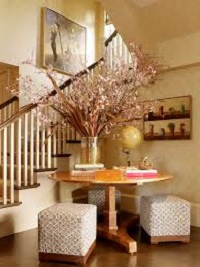 Your home’s entryway is a unique space; heavily trafficked, it needs to be tidy and functional for daily lives, yet beautiful and inviting for guests. “After all, it’s the first space guests see and a good first impression is imperative,” said Paulette Sodemann, Sales Design Consultant with Callen. “Not all entryways are created equal, as some homes have small entrances, some have large foyers, others have entrances that immediately bring you into another room, like the living room, for example,” she added. Paulette explores the general rules of thumb for making the entryway a successful space, regardless of size.
Your home’s entryway is a unique space; heavily trafficked, it needs to be tidy and functional for daily lives, yet beautiful and inviting for guests. “After all, it’s the first space guests see and a good first impression is imperative,” said Paulette Sodemann, Sales Design Consultant with Callen. “Not all entryways are created equal, as some homes have small entrances, some have large foyers, others have entrances that immediately bring you into another room, like the living room, for example,” she added. Paulette explores the general rules of thumb for making the entryway a successful space, regardless of size.
First, if your home is lacking a defined entry, utilize furniture and furnishings to create the illusion of one. “Adding an entrance rug or changing the flooring is a perfect way to define a space,” she said. You can also arrange furniture to create the essence of a hallway. However, it may be helpful to use a double-sided bookshelf or a low sofa back to create the entrance, if you choose not to create a tall “hallway” from your furniture. For example, if your home opens into an open living room, you’ll want to face the back of the sofa towards the entry and place a sofa table along the back of the couch. This separates spaces, which helps create a defined entry, and serves as a place to put decorations and store belongings.
Next, no matter the type of entry, you’ll want to trap dirt. “The entryway endures chronic foot traffic and wherever you live, trapping leaves, mud, dust, sand, or snow can help save the rest of your flooring throughout the house,” said Paulette. She suggests using a durable rug designed for the entry and make sure it can be easily vacuumed, cleaned, or shaken out. Another option is placing a heavy-duty entrance mat outside the front door and have a second rug or mat inside the door.
“Sometimes you need to make necessary changes to your entryway that are beyond decorating. For example, you want to add a built-in closet, add lighting, or build a half-wall. Or perhaps you might have an entry closet that might look better without its doors,” Paulette said. “It’s imperative to get a professional opinion as to what is possible before walls are moved or flooring is replaced.”
Subsequently, you’ll want to add order. Often times if a home has one main entrance, it is likely that it is used as a staging ground, a natural place to leave items when entering and leaving the home. Before installing organizational items, carefully assess needs. If coats, backpacks, and bags are an issue, hang as many coat hooks or pegs as possible. If shoes are the culprit, get some bins or low shelving. Some families like to have individual organizers for each member – making it simple to put things away. Whatever works for your family, add pieces that will help you organize this space.
Next, be sure to maximize vertical space if the entryway has walls. Whether you choose to hang art, photos, family calendars, or shelves, using available wall space will not only keep the space organized, it will make it look bigger. Decorating the walls is the quickest way to add a sense of depth to a space and it’s a great way to interject style to your entrance.
“You may want to consider extending the entryway past the front door, if you have a small entrance,” she said. A covered porch or stoop is a good place to keep items that you don’t have room for. Umbrella stands, welcome mats, or decorative objects can easily live outside instead of inside. Some homes have a double-entrance in which a mudroom can serve as a catch-all for a variety of objects before a person actually enters the home. “This style of entrance works great in regions with low temperatures because the double set of doors helps keep heat inside the home while a person removes their coat and shoes,” she said.
Remember to add lighting because you’ll want the entrance well-lit for several reasons. Safety is a number one concern; as soon as you walk in the door you’ll want to make sure you can see inside the home. Also, you’ll want to see your belongings – especially if getting ready to leave means getting ready before the sun rises. Light fixtures help set off an entryway and help make the area appear more spacious. Consider table lamps if you can’t add overhead lighting and choose energy efficient bulbs because they have a longer lifespan.
If space is available, a bench can be a great spot for people to sit and put on or remove shoes or hold purses or other objects. For extra organization, consider adding a storage bench or a bench with a shelf.
Don’t forget to add personality. The entry to the home is the ideal place to embrace an owner’ style. “When guests arrive, you want them to immediately sense who you are and how they think of your home. It’s a great place to add your favorite colors, objects or collections,” Paulette said. What is added will depend greatly on available space. Larger entrances have room for a center table, piano seating, and other decorative objects. Other homes only have room to hang a few pictures. “You can experiment by moving objects around or playing with colors. You’ll want to make sure that the décor is in accordance with the style and colors of the surrounding rooms,” she said.
And finally, mirror or no mirror. The idea of hanging a mirror in the entrance is arguable. “If you lean towards a more traditional, American or European style, a mirror can help reflect light into the entrance and allow you to check your appearance before leaving the house,” Sodemann said.
“Following these 10 principles for decorating your entryway will ensure that your entrance is both functional and beautiful,” she concluded.
For more information or to arrange an initial Design Center consultation, call Callen at 414-529-5509.



Leave a Reply